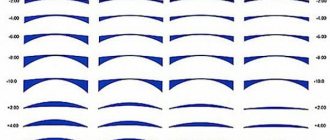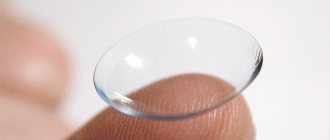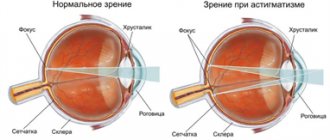What you need to know about lenses
Designed for one month of use, the lenses are soft contact lenses that can be worn for up to thirty days. It is recommended to remove them at night, having first cleared them of accumulated deposits and small particles of debris. The next morning, a cleaned and disinfected pair of lenses is put on.
The big advantage of monthly lenses is that they save money due to their long use time. The package can contain from three to six blisters. If the package contains six blisters, then the lenses will last for three whole months.
Air Optix Night {amp}amp; Day Aqua
Experts recommend wearing monthly soft contact lenses in the following cases:
- If the sebaceous glands secrete a large amount of secretion, which contributes to the accumulation of sediment.
- People who have suffered various complications and inflammations of the eyes.
- If the lenses are easily lost and torn.
- People whose profession involves prolonged exposure to dusty conditions, interaction with chemical reagents and other unfavorable factors.
One-month contact lenses have many advantages, which is why they are so popular among those who use such optics.
Main advantages:
- Such lenses have the most comfortable and optimal wearing period. Within thirty days, protein deposits do not have time to accumulate on their surface. Therefore, the lenses are comfortable and absolutely safe, but subject to the rules for caring for contact lenses, this article will tell you more about this.
- Monthly lenses can be purchased at an affordable price. Usually you have to pay about one and a half thousand rubles for a package with three pairs of lenses.
- The material used to make these lenses is completely harmless. It does not cause discomfort and does not adversely affect eye tissue. The material has a sufficient degree of moisture and oxygen permeability, so that the eyes do not experience dryness and constantly “breathe”.
- The wide range of corrections in which monthly contact lenses are available allows you to correct vision for both nearsightedness and farsightedness at the same time, as well as astigmatism. It usually varies from plus six to minus twelve diopters. (Optical correction is the most common treatment for astigmatism.)
- There are monthly colored and tinted lenses that can be used both to correct vision pathology and to create an image.
Bausch{amp}amp; Lomb
Contact lenses with a wear period of three months are also called quarterly or scheduled replacement lenses. They are perfect for vision correction for myopia and farsightedness. Experts call this type of lenses transitional between contact optics of planned replacement and traditional ones.
Hydrogel is most often used as a manufacturing material. It may differ in its characteristics, for example in moisture content. Another material for making lenses for three months is silicone hydrogel (silicone hydrogel lenses).
Air Optix Individual – three-month contact lenses
Quarterly contact lenses have a large number of advantages:
- They provide high quality vision throughout the entire period of use.
- The lenses are made of fairly durable material that protects them from damage.
- They have a good degree of hydration, so the eyes do not feel dry and tired.
- Many lens models have a special filter that protects the eyes from the harmful effects of ultraviolet radiation.
- Such lenses are presented not only in classic transparent models, but also in colored and tinted ones, which can be used both for vision correction and for a cosmetic effect.
Which ones are right for me?
Acuvue Oasys and Biofinity contact correction products use different technologies, but both do not cause dry eyes if you work a lot at the computer or spend a long time in rooms with low humidity and other unfavorable conditions. Acuvue is suitable if you prefer routine replacement models and want to save money on your purchase, as well as if you need additional sun protection.
Biofinity are more expensive, but they are optimal for people with vision problems - the line offers a wide range of diopters, which not every product has. In addition, you can choose a prolonged wearing mode, which is important for people with an active lifestyle, rotational or shift workers, and travelers.
Remember that the decision about which lenses to buy should be made with your doctor. The specialist will recommend the best option, taking into account the characteristics of your eyes and lifestyle.
MagazinLinz.ru team
Specifics of wearing mode
As the name suggests, monthly lenses can be worn for thirty days, that is, one month.
A damaged lens must be replaced, otherwise microscopic cracks and scratches can cause a lot of discomfort and cause traumatic effects on the ocular surface. Every day before going to bed, it is recommended to remove your lenses, clean and disinfect them with a special solution for contact lenses, and leave them in a storage container for at least a few hours.
The mode of wearing contact lenses for a month has its own specific characteristics. You can use the lenses in daytime mode. In this case, the lenses must be removed at night. And in prolonged (read what this means and about long-term wear lenses here) or continuous mode - you can even sleep in the lenses.
As you understand, not everyone can afford daily lenses due to their high cost. It is much cheaper to buy durable products. There are two types of monthly lenses:
- daytime;
- extended wear lenses that you can sleep in.
The second type of lenses is usually made of silicone hydrogel material, which has excellent oxygen permeability and does not have a low elasticity coefficient. Long-term wear lenses are comfortable to sleep in. Moreover, with continuous use, the patient forgets that there are foreign objects in the eyes.
Read more about soft lenses here.
As mentioned earlier, three-month lenses are made of dense but durable material. Despite its resistance to damage, it does not have very high gas permeability, unlike the material of daily contact lenses. Therefore, quarterly contact lenses can only be worn during the day and for no more than eight hours at a time.
Square contact lenses
You should not leave quarterly lenses in overnight and sleep in them during the day, as hypoxia may develop or a lot of deposits will accumulate on their surface.
Contact lenses - a current trend in optics
Modern statistics show that the number of people with low vision is steadily growing. This is due to the constant use of computers, background nervous tension and many other factors.
And this, in turn, leads to the growing relevance and development of optical salons throughout the country.
And if a few years ago a person with poor vision could be easily recognized on the street by the presence of glasses, today, keeping up with the times and not wanting to stand out from the crowd on this basis, people increasingly prefer contact lenses.
Tips for choosing lenses
The selection of contact lenses begins with collecting information about the patient (age, profession, diseases, etc.). A near and far vision test is then done. To test far vision, special tables or a sign projector are used. And for the neighbor - a table with text. In addition to these tests, others can be used. After this, objective refraction is determined using an autorefractometer. And with the help of trial lenses - subjective refraction.
Next, the parameters of the cornea are measured using an ophthalmometer or autorefractometer, and eye biomicroscopy using a slit lamp. If during the examination the doctor finds any contraindications to the use of lenses, then appropriate therapy is prescribed, after which the selection of lenses can be continued. If there are no contraindications, then the ophthalmologist selects the type of lenses, wearing regimen, and replacement period.
After this, the optical power, radius of curvature and lens diameter are calculated. And special disposable diagnostic lenses are tried on.
Clear Lab is one of the most sought after manufacturers
A comprehensive selection examination should include the following steps:
- Definition of the “leading” eye;
- Determination of distant visual acuity using tables or a sign projector;
- Determination of near visual acuity using a tex tablet;
- Determination of refraction by an objective method of autorefractometry;
- Determination of refraction by a subjective method using diagnostic lenses with different parameters;
- Study of binocular balance of selected lenses;
- Study of the accommodative ability of the eyes;
- Carrying out biomicroscopy using a slit lamp;
- Determination of the radius of curvature, diameter of the cornea using keratometry;
- Selection of contact lenses taking into account the collected medical history;
- Trying on trial diagnostic lenses to assess the quality of vision and their fit;
- Assessment of adaptation to lenses after keeping them on the eyes for twenty to thirty minutes;
- Training in proper handling and care of lenses;
- Issue a prescription, set a date for a follow-up examination.
Read about how long you can wear daily lenses by following the link.
Tips for caring for lenses
Lenses for three months, just like other types of contact lenses, are subject to mandatory care. It is quite simple, but all procedures must be performed daily.
- Manipulate lenses only with clean hands. All other devices (tweezers, container) must also be perfectly clean.
- You cannot wear lenses longer than the period stated by the manufacturer.
- Before putting on your lenses, you should inspect them for damage or remaining deposits. If the lenses are torn, they must be replaced.
- During illnesses with viral infections, you should stop wearing lenses so as not to transfer the infection to your eyes.
- All care, cleaning and disinfection products must be compatible with the lenses.
- You cannot wear other people's lenses and give yours to other people. This is fraught with conjunctivitis and other infections.
- If you experience discomfort, stop wearing lenses and consult a doctor.
Read about the mode of wearing day lenses in the material.
Daily lens care should include cleaning the surface of the lenses from deposits, rinsing and disinfecting.
Computer perimetry of the eye is described here.
Useful tips:
- Lenses should be cleaned immediately after removal.
- Under no circumstances should the universal disinfection solution be replaced with saline solution.
- If the lens is damaged, it must be replaced.
- Lenses should only be removed and put on with clean hands.
- The solution cannot be reused.
- The lenses must be completely immersed in the solution.
- The lid of the container must be tightly screwed on to prevent the lenses from drying out.
conclusions
Monthly lenses are very comfortable. They have a large number of advantages that make them so popular. If you want to choose monthly lenses, then do not neglect going to a specialist who will help you choose contact optics taking into account all the features of your eyes and vision. You should remember the rules for using contact lenses. Compliance with all recommendations will prevent the occurrence of serious complications.
How to choose the right lenses for your eyes, read the link.
Three-month lenses are available in a wide variety of brands. In order not to make a mistake in your choice, the first thing you need to do is consult an ophthalmologist. He will select lenses taking into account all individual features.
You should adhere to the rules of wearing and care, then serious and dangerous consequences will bypass you.
You can read about Oasis Acuvue contact lenses here.
So, which lenses are better: daily or monthly? At the moment, there is a large assortment of the best contact lenses on the market. Choose the appropriate option depending on the results of research from a specialist, as well as based on the image and lifestyle that you prefer. Whatever lenses you choose, the main thing is to be responsible about the timing and rules of use. In this case, you are unlikely to encounter any problems caused by wearing your lenses incorrectly.
Types of lenses and their classification
By type, lenses can be optical, that is, for vision correction, and cosmetic, which are used for beauty.
They are mainly divided according to the type of their use:
- Extended wearing. Long-term use, you can not remove it while sleeping.
- Daytime wear. Operation only during daytime. They should be removed in the evening to give your eyes a rest.
Putting on the optical lens
For each person, lenses must be selected in accordance with the characteristics of the eyes, based on the studies performed and prescribed by the doctor.










